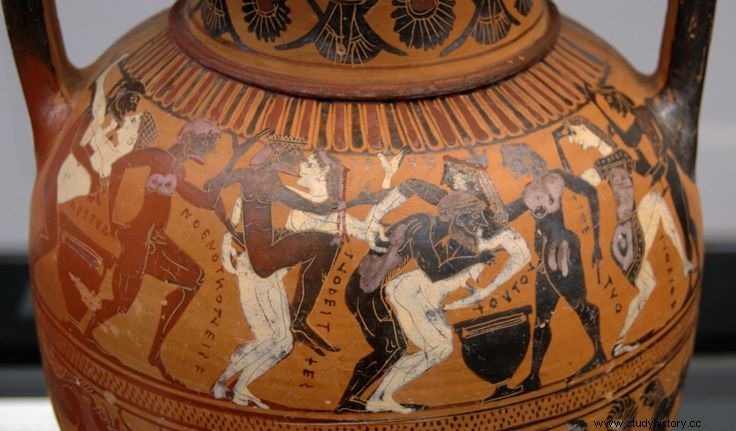Unlike what happened in Mesopotamia or Egypt, where wine was a luxury item only available for the wealthiest classes or special celebrations, in ancient Greece, given the weather and soil conditions, wine became a product affordable for all social classes. In addition to improving viticultural techniques and winemaking processes that increased the yield of the vines, the Greeks were the first to produce wine on a commercial scale, becoming one of the main export products. They brought the culture of wine to all their colonies in the Mediterranean and even among the Greek polis the cultivation of cereals was replaced by that of the vine - it was much more profitable to plant vines than cereals-; to the point that many city-states had to import the once surplus grain. It was so affordable that even the slaves consumed it, so drinking wine ceased to be an exclusive practice of the upper social classes. From that moment, the Greeks began to give importance to the origin of the wine and, also, to its age, the older the better. Logically, this implied that the amphorae in which the wine was transported and stored had to be “labelled”.

Greek krater
The Greeks came to associate drinking wine with civilized culture, distinguishing themselves from the barbarians who drank beer or, worse, undiluted wine. Because the Greeks did not drink pure wine, they added water to the wine -never the other way around- and always in a higher proportion of water than wine (a mixture of equal parts was considered strong wine). If there was a ritual associated with the consumption of wine in Greece, it was the symposium . It was the time for drinking and chatting among the guests after finishing the main meal (deipnon ). At the end of the meal, the servants cleared the tables, decorated the guests with wreaths of ivy and branches, poured some perfumes over them, began to circulate cups that were filled in the krater (containers or pots made of clay where he mixed water and wine for the guests) and a referee was chosen for the talks. The toasts and talks that followed could go on happily into the night.

The wine animated the celebration and the krater ensured the festive circulation of the toasts that had a lot of ritual. They began with libations of wine poured in honor of the gods; then, under the protection of the gods Dionysus and Zeus, the rest of the pleasures of the symposium unfolded:perfumes, songs, music, dances, games, talks, drunkenness... and eroticism. The guests were only men, the women of the house did not attend but they did admit hetairas , great dancers, excellent flutists and better lovers. This created a pleasant atmosphere in which the participants commented on their occurrences and talked casually, especially about love and politics. In the words of the Greek historian and philosopher Xenophon…
in the symposia sorrows are numb and the loving instinct is awakened.

An important figure in this ritual was that of the symposiarch , which could be the host or someone from the group chosen by vote. He was the one who decided the proportion of the mixture and the number of kraters that were going to be served. Normally, for a quiet meeting, there were three; from the fourth the regional songs and the signs of exaltation of friendship began to be sung; with the fifth the furniture was in danger and the philosophical talks turned into heated discussions; with the sixth, words were passed into hands... And although it was normal for the symposium It started and ended at the host's house, whether it was each owl returning to its olive tree or sleeping it off where everyone was caught, sometimes the party continued in the street... it was the komos . The guests, accompanied by music, continued the party walking the streets, like friends on a night out (komoidós ) and singing satirical and obscene songs in which they made fun of specific citizens or current events. Depending on the degree of drunkenness and the craters consumed, the party could end up in a "police station" due to fights and acts of vandalism... We haven't changed that much anyway. And from this partying and messing around (komos ), our comedy.
Nowadays, the symposium has an academic character, in the format of seminars, and in them ideas or new discoveries are exchanged and debate is encouraged. Of course, the recreational part (the wine and the hetairas) has been eliminated... or that is what the attendees say.
